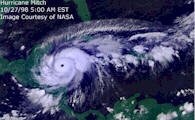 |

 |
|
 |
| By Seth Dunn & Christopher Flavin
Insurance companies have paid out $91.8 billion in losses from weather-related natural disasters in the 1990s so far, close to four times the weather-related claims handed out during the entire decade of the 1980s. At $15 billion, weather-related insured losses in 1998 were second only to the $25 billion recorded in 1992, according to the recently compiled estimates from the German reinsurance company Munich Re.
The largest insurance claims of 1998 were from Hurricane Georges, which hit the United States and the Caribbean, costing insurers $3.3 billion; from the ice storm that swept across the U.S. and Canada, bringing $1.2 billion in insured damages; and from flooding in China, which cost the industry $1 billion. Munich Re estimated in its 1998 year-end report that the number of natural catastrophes has tripled since the 1960s, increasing the overall cost to the world's economies nine-fold, and the cost to the insurance industry fifteen-fold.
Climate change has added a new element of risk to the insurance equation. Rising temperatures increase the amount of evaporation from the oceans, which tends to increase rainfall in many flood-prone areas. In addition, higher temperatures add to the heat energy that fuels thunderstorms, tornadoes, and hurricanes. Gerhard Berz of Munich Re recently said, "A further advance in man-made climate change will almost invariably bring us increasingly extreme natural events and consequently increasingly large catastrophe losses." Another factor in the escalating cost of insured losses has been the effort of governments and insurers in industrial nations to make inexpensive insurance protection widely available, encouraging a coastal migration trend that has dramatically increased the amount and value of property at risk to storm damages. Research by the reinsurance company Swiss Re indicates that the relatively catastrophe-free years of the 1960s and 1970s gave property owners a sense of complacency, leading them to build heavily in disaster-prone areas. Some $2 trillion in insured property now lies within 30 kilometers of coasts exposed to Atlantic hurricanes. Recent studies find that a single weather-related catastrophe could endanger the solvency of many insurance companies. A computer simulation by the Arkwright Mutual Insurance Company, presented at the annual meeting of the American Meteorological Society in 1998, indicates that the U.S. East Coast is exposed to "unprecedented hurricane damage" due to explosive coastal property growth that coincided with unusually low hurricane activity between 1940 and 1990.
 The study estimates the Eastern U.S. could face hurricane losses of $50 to $100 billion,
placing numerous insurers and re-insurers in danger of insolvency. Citing the
president of a reinsurance industry group who believes that a $50 billion
hurricane would exceed the financial capabilities of the insurance industry, the
Arkwright report concludes: "we are...an industry with a disaster waiting to
happen."
The study estimates the Eastern U.S. could face hurricane losses of $50 to $100 billion,
placing numerous insurers and re-insurers in danger of insolvency. Citing the
president of a reinsurance industry group who believes that a $50 billion
hurricane would exceed the financial capabilities of the insurance industry, the
Arkwright report concludes: "we are...an industry with a disaster waiting to
happen."
A 1998 study by the U.S. National Oceanic and Atmospheric Administration (NOAA) emphasizes the growing vulnerability of populations and property to hurricanes. Comparing normalized hurricane damages between 1925 and 1995, the report concludes "it is only a matter of time before the nation experiences a $50 billion or greater storm, with multi-billion dollar losses becoming increasingly frequent." According to NOAA research released this past January, the U.S. has already seen 37 "billion-dollar storms" since 1980-31 of them since 1988-totaling $160 billion in damages. The danger to insurers of higher storm damages has led to the emergence, in private financial markets, of "catastrophe bonds" and other means of hedging risks that the insurance industry will not cover. Meanwhile, the insurers and reinsurers that have traditionally resisted government attempts to regulate the private insurance market are now looking to the public sector for help.
 Last year, industry representatives testified before the U.S. Congress, calling on
the federal government to provide a "backstop" of reinsurance protection for
states and insurers in the event of natural disasters that yield damage claims
beyond their financial resources.
Last year, industry representatives testified before the U.S. Congress, calling on
the federal government to provide a "backstop" of reinsurance protection for
states and insurers in the event of natural disasters that yield damage claims
beyond their financial resources.
As a representative of the American Insurance Association told Congress, the U.S. economy and insurance industry are "simply not prepared" for a massive hurricane and its socioeconomic effects. The Florida State legislature is also appealing to the federal government to create a natural hazards insurance program to provide reinsurance for catastrophic events. A 1998 working paper from the Natural Hazards Center at the University of Colorado, Boulder reveals that Florida is still in the midst of an insurance crisis six years after experiencing the largest insured loss event in history, Hurricane Andrew, which caused $16 billion in insured losses. Andrew left seven insurance companies insolvent, and led 44 to reduce their exposure by reducing coverage and raising premium levels. Thousands of people were left without insurance and unable to collect claims, and many insurers sought to leave the state. To ensure available and affordable coverage, the state government has established a public underwriting agency, now the state's second largest insurer, and created funds to cover insurers for hurricane catastrophes and homeowners for wind damages. As a result, Florida taxpayers are now underwriting at-risk homeowners who private insurers are unwilling to cover, reinsuring insurers against weather-related catastrophes, and propping up the state's home building industry and its relentless construction in high-wind risk areas.
In China, the Yangtze floods displaced 223 million people--close to the entire U.S. population. As developing nations attempt to build an infrastructure and economic base, some may find insurance rates prohibitive because of their demonstrated vulnerability to extreme weather events. Already, many insurers have raised premium rates for, and some have withdrawn property insurance entirely from, islands like Jamaica following the destructive hurricane Hugo of the late 1980s. Increasingly hazard-prone regions in the Caribbean as well as the Pacific are finding insurance very expensive or impossible to obtain. Many poor, low-lying islands and coastal nations in the Caribbean, Indian, and Pacific Oceans depend on insurance to attract investment in their tourism sectors, which account for as much as 70 percent of their gross national products. These nations, highly susceptible to rising sea levels and storm surges, may see their real estate values drop as investment patterns shift in response to the reduced availability and affordability of property insurance. The banking industry has already seen the withdrawal of coverage for properties on small islands that were being considered for long-term financial investments. Heavy uninsured losses may also bring loan defaults, and because property is often used as security for loans, some experts fear falling property values could trigger a "credit famine" in local economies. As storms become more frequent and intense, phenomena like these may spread to other parts of the world. |

© 1997-99 BEI
 Hurricane Mitch caused billions of dollars of damage in Central America last year
Hurricane Mitch caused billions of dollars of damage in Central America last year  The Yangtze River
The Yangtze River